The Economics and Statistics Division maintains archives of previous publications for accountability purposes, but makes no updates to keep these documents current with the latest data revisions from Statistics Canada. As a result, information in older documents may not be accurate. Please exercise caution when referring to older documents. For the latest information and historical data, please contact the individual listed to the right.
<--- Return to Archive
For additional information relating to this article, please contact:
June 26, 2023CULTURE AND SPORT INDICATORS, 2021 Statistics Canada has updated indicators of Canada's culture and sport activities for 2021. Because many of these activities were directly and substantially diminished by COVID-19 restrictions in 2020 as they involve extended close contact in crowded settings. As these restrictions on culture and sport activities were lifted in 2021, GDP and employment from production of culture products rebounded.
Nova Scotia's GDP from cultural production increased by 7.3% from 2020 to 2021, while the province's GDP from sport increased by 5.6%. Nationally, GDP from culture increased by 8.3% while GDP from sport was up 7.0%. All provinces reported rising GDP for both culture and sport production. British Columbia reported the fastest gain in culture GDP (Alberta the slowest) while Manitoba reported the fastest gain in sport GDP (Saskatchewan the slowest).
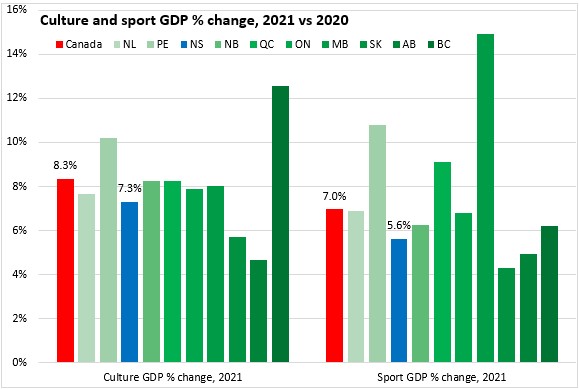
Nova Scotia's production of culture products generated $975.9 million in nominal GDP in 2021. This was 1.9% of Nova Scotia's nominal GDP. Across Canada, GDP from culture was 2.2% of national GDP in 2021, with the highest shares in Ontario and British Columbia. Culture was the lowest share of GDP for Saskatchewan.
GDP from sport in Nova Scotia was $166.3 million; 0.32% of provincial GDP. National sport production accounted for 0.25% of Canada's GDP (highest shares in Nova Scotia and Manitoba, lowest share in Québec).

Production of culture and sport products are labour intensive. Nova Scotia's employment in culture products rebounded with 9.2% gain in 2021 (+11.0% nationally). Sport employment was up 6.2% in Nova Scotia (+7.7% nationally). British Columbia reported the fastest growth in culture employment while Manitoba had the fastest growth in sport employment. Culture employment growth was slowest in Saskatchewan, Alberta and New Brunswick. Sport employment growth was slowest in Saskatchewan and British Columbia.
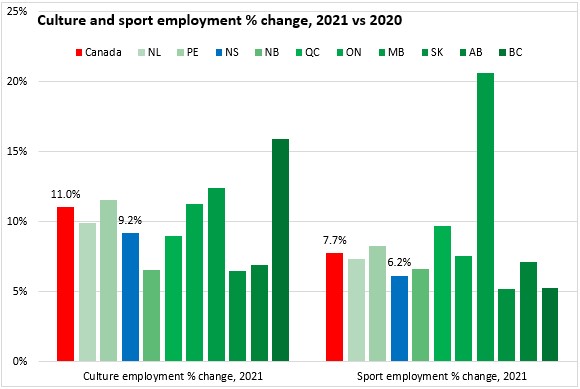
In Nova Scotia, there were 12,751 jobs in cultural production, amounting to 2.7% of provincial employment. Sport production added a further 2,518 jobs; 0.53% of Nova Scotia's employment. Nationally, culture accounted for 3.3% of employment (highest share: British Columbia, lowest share: New Brunswick). Sport accounted for 0.47% of national employment in 2021 (highest share: British Columbia, lowest shares: New Brunswick and Québec).
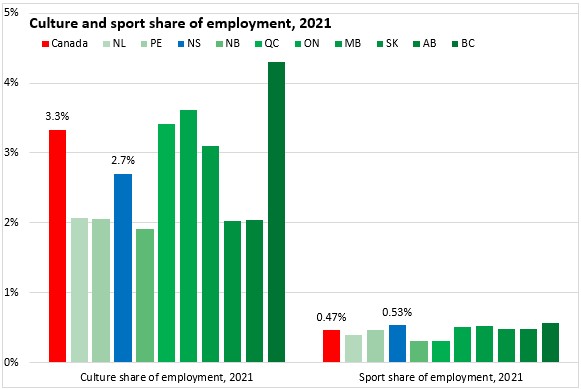
Both culture and sport GDP rebounded for Nova Scotia (in nominal terms) in 2021, returning to a rising trend after the pandemic-related slowdown.

Nova Scotia's employment in culture and sport rebounded to levels just below those observed in 2019.
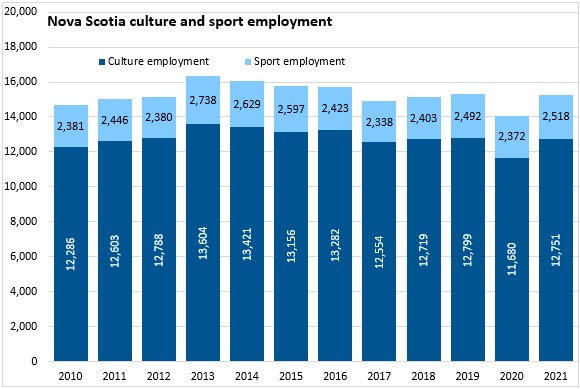
Production of culture and sport products are divided into several domains and sub-domains. In this categorization, all Federal, Provincial and municipal government-owned institutions (except schools, colleges and universities) are classified under "governance, funding and professional support" even when their activity falls within the scope of another sub-domain. "Multi-domain" categories include industries that may be associated with more than one domain (examples: convention/trade show organizers, lessors of non-financial intangible assets).
Governance, funding and professional support (ie: government institutions) account for the largest shares of GDP and employment in culture and sport production.
Audio-visual and interactive media account for the second largest portion of Nova Scotia's culture and sport GDP; the majority of this GDP is generated from broadcasting.
Sport production accounts for the third largest part of culture and sport GDP in Nova Scotia. Education and training accounting for the majority of sport GDP, with an even larger contribution to GDP than education and training in culture.
Visual and applied arts were the fourth largest contributor to culture and sport GDP with the bulk of activity concentrated in design, architecture and advertising sub-domains.
Written and published works were the fifth largest contributor to Nova Scotia's culture and sport GDP, followed by live performance and (private) heritage and library institutions.
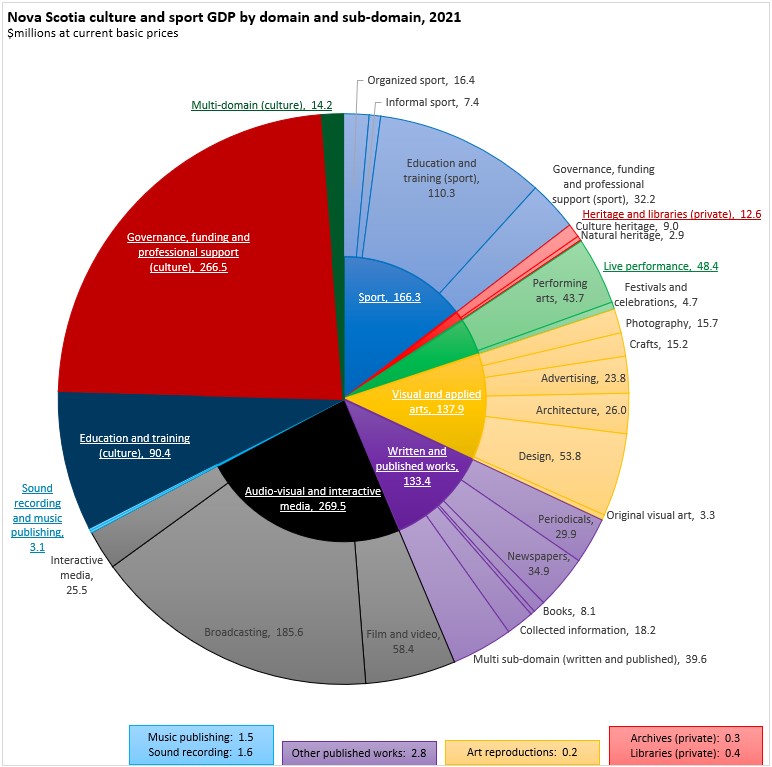
Each domain's contributions to Nova Scotia's culture and sport employment differed somewhat from the contributions to GDP. Governance, funding and professional support in culture remained the largest contributor. Sport was the second largest contributor to employment. Although audio-visual and interactive media was the third largest contributor to employment, jobs in film and video were larger than employment in broadcasting. Notably, employment in performing arts made up a substantially larger share of culture and sport employment than it did of culture and sport GDP.
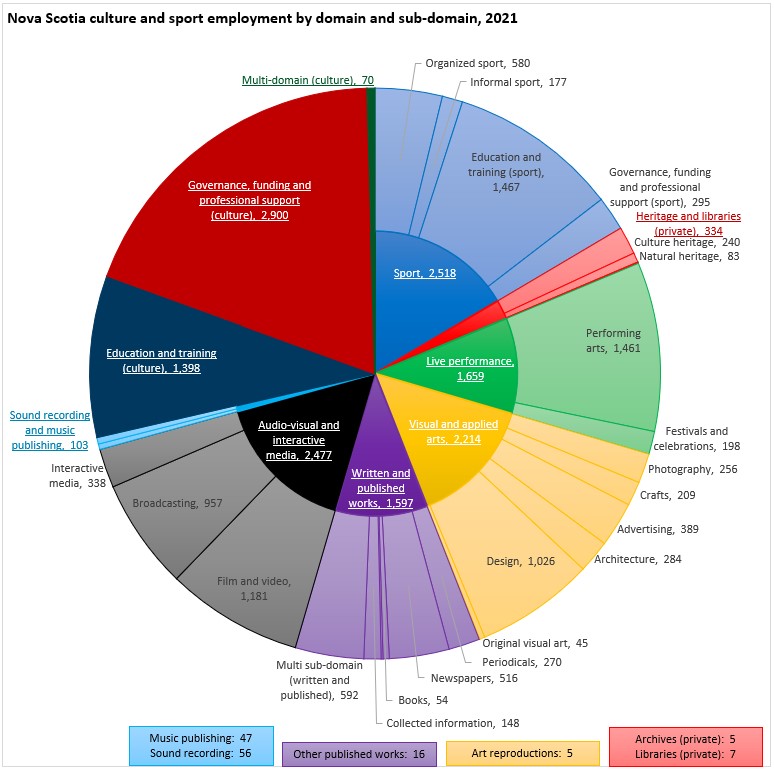
Notes: culture and sport share of GDP are calculated using GDP by income, adjusted for taxes less subsidies on products and imports; employment shares calculated using job totals from labour productivity tables
Source: Statistics Canada. Table 36-10-0452-01 Culture and sport indicators by domain and sub-domain, by province and territory, product perspective (x 1,000); Table 36-10-0221-01 Gross domestic product, income-based, provincial and territorial, annual (x 1,000,000); Table 36-10-0480-01 Labour productivity and related measures by business sector industry and by non-commercial activity consistent with the industry accounts
<--- Return to Archive